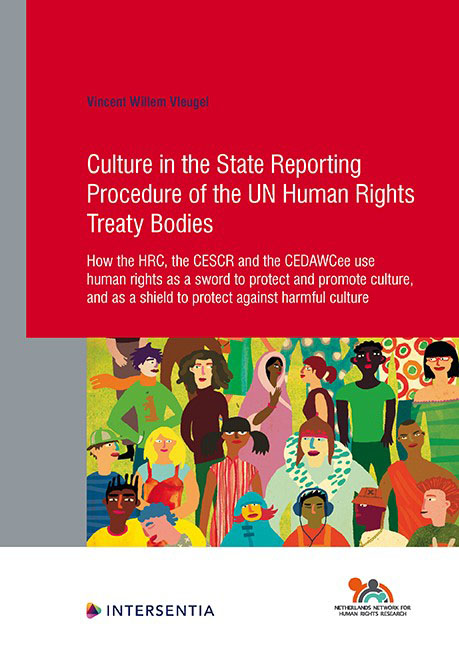 Culture in the State Reporting Procedure of the UN Human Rights Treaty Bodies
Culture in the State Reporting Procedure of the UN Human Rights Treaty Bodies Book contents
- Frontmatter
- Acknowledgements
- Contents
- Abbreviations
- Note on Citation Formats
- Note on Grammar
- Chapter 1 Introduction
- Chapter 2 Human Rights and Cultural Diversity. Between and Beyond Universalism and Cultural Relativism
- Chapter 3 UN Treaty Bodies. Treaties, Committees, Working Methods
- Chapter 4 Human Rights as a Sword. To Protect and Promote Cultural Diversity
- Chapter 5 Human Rights as a Shield. To Protect against Harmful Aspects of Culture
- Chapter 6 Cultural Argumentation. The State Reporting Procedure as a Platform for Cross-Cultural Dialogue
- Chapter 7 Conclusions. How the Treaty Bodies Universalise Human Rights
- Bibliography
- Summary
- Samenvatting
- Human Rights Research Series
Chapter 5 - Human Rights as a Shield. To Protect against Harmful Aspects of Culture
Published online by Cambridge University Press: 11 November 2021
- Frontmatter
- Acknowledgements
- Contents
- Abbreviations
- Note on Citation Formats
- Note on Grammar
- Chapter 1 Introduction
- Chapter 2 Human Rights and Cultural Diversity. Between and Beyond Universalism and Cultural Relativism
- Chapter 3 UN Treaty Bodies. Treaties, Committees, Working Methods
- Chapter 4 Human Rights as a Sword. To Protect and Promote Cultural Diversity
- Chapter 5 Human Rights as a Shield. To Protect against Harmful Aspects of Culture
- Chapter 6 Cultural Argumentation. The State Reporting Procedure as a Platform for Cross-Cultural Dialogue
- Chapter 7 Conclusions. How the Treaty Bodies Universalise Human Rights
- Bibliography
- Summary
- Samenvatting
- Human Rights Research Series
Summary
INTRODUCTION
The present chapter examines how the treaty bodies deal with ‘adverse’, ‘negative’ or ‘harmful’ aspects of culture. While chapter 4 examined how States are to respect, protect and promote culture and cultural diversity, chapter 5 examines the obligations of States parties to promote changes in cultures. Cultures can manifest themselves in harmful values (stereotyping, attitudes) and practices (FGM, early marriage, etc.). As such, culture (in the form of practices, customs, traditions) can directly infringe upon human rights, or (in the form of stereotyping, attitudes) it can serve as an obstacle or barrier to the enjoyment of human rights. In order to map and analyse how the treaty bodies approach adverse, negative or harmful aspects of culture, three steps are to be taken. First, it is important to determine which concerns the treaty bodies link to culture. In general, it appears that for all three treaty bodies the vast majority of the issues linked to culture relate to different forms and manifestations of discrimination against women. Other issues relate to sexual and gender identities, such as lesbian, gay, bisexual, transgender and intersex persons (henceforth referred to as LGBT+) and other vulnerable or disadvantaged groups. Step 2 examines how the treaty bodies link these concerns to culture. Is the link clear, explicit and direct? Or is it ambiguous, implicit and indirect? Finally, the related recommendations are examined, with a view to outlining State obligations: are States parties required to address or challenge the culture, and how? If culture is (implicitly or explicitly) identified as contributing to situations of problematic implementation, do States (automatically) have to address that culture? What are the proposed (legal and other) measures or solutions?
It is necessary to address some additional methodological choices here. For one, there is the choice to distinguish between explicit and implicit links to culture. The link with culture is considered explicit when the treaty bodies explicitly – i.e., openly, plainly, unambiguously – link the problem to culture, custom or tradition, or to cultural attitudes, stereotypes or stigma. Such ‘link’ to culture may take many forms. When few women participate in political and public life, and this is ‘perpetuated by’ the persistence of stereotypes, this is a link to culture.
- Type
- Chapter
- Information
- Culture in the State Reporting Procedure of the UN Human Rights Treaty BodiesHow the HRC, the CESCR and the CEDAWCee use human rights as a sword to protect and promote culture, and as a shield to protect against harmful culture, pp. 151 - 236Publisher: IntersentiaPrint publication year: 2020


